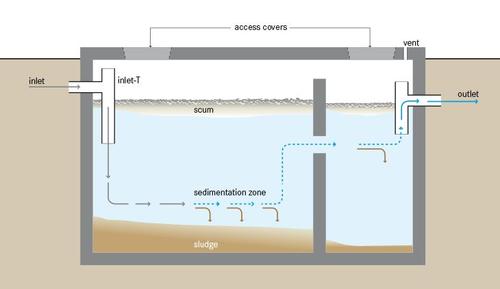A septic tank is a watertight tank, which is usually located just below ground and receives both blackwater and greywater. It can be used with pour flush toilets or wastewater from residential buildings and small businesses. It functions as a storage tank for settled solids and floating materials. The storage time of the wastewater in the tank is usually between 2 and 4 days. About 50% removal of BOD and suspended solids is usually achieved in a properly operated septic tank due to the settling of the solids during wastewater storage. A septic tank can be partitioned into two chambers. In the first chamber solids settle and in the second anaerobic bacteria in the sewage break down the organic matter. Periodically, the solid matter in the bottom of the tank must be removed and disposed properly. The discharge of the second chamber is directed into a leach pit (similar to pit latrine) or trench. A trench is usually filled with gravel and a distribution pipe for the wastewater is placed in this gravel layer. Soil is placed above this gravel layer. The septic tank overflow undergoes further bacterial decomposition as it percolates through a leach pit or trench. Soil bacteria, usually under aerobic conditions undertake the decomposition and lowering the BOD. Nutrients are not removed significantly by the bacteria and usually pollute the groundwater. Pathogenic bacteria are removed by die-off or filtration by the soil, but viruses may travel further in the soil or groundwater. (UNEP 2000 & EPA 2004)
